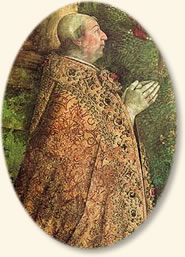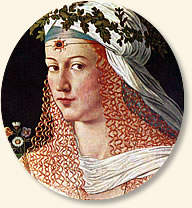|
The Death of Pope Alexander VI, 1503
The collapse of the Western Roman Empire in the 5th century created a political and cultural vacuum that was filled, in part, by the Roman Catholic Church. For the next 1000 years the continuity of the Church of Rome provided a semblance of stability as Europe sank into barbarism. By the dawn of the Renaissance, however, the mission of the papacy had been corrupted by the conflict between its sacred duties as the Vicar of Christ and its temporal responsibilities as head of the Papal States. This was not the papacy's finest hour.
 |
| Pope Alexander VI |
Pope Alexander VI epitomizes this corruption. Born as Rodrigo Borgia in Spain
in 1431, he was elected Pope in 1492, an event that spawned rumors that he had
spent a considerable fortune bribing the appropriate Cardinals to assure his
success.
The new Pope loved the good life. He sired at least twelve children through a number of mistresses. The most famous of his offspring were his son Cesare, noted for the murder of political rivals, and his daughter Lucrezia who was married off to a number of husbands for political gain.
Pope Alexander VI was in constant need of money - to support his lavish life
style, to fill the coffers for his political bribes and to fund his various military
campaigns. The sale of Cardinalships was a major source of cash, so too was the
sale of indulgences. An indulgence was a written proclamation that exonerated
- for a fee - the individual (or his relatives) from punishment in the after-life
for sins that had been committed, or in some cases, may be committed in the future.
Fourteen years after his death, the corruption of the papacy that Alexander VI
exemplified - particularly the sale of indulgences - would prompt a young monk
by the name of Martin Luther to nail a summary of his grievances on the door
of a church in Germany and launch the Protestant Reformation.
Johann Burchard was a Papal Master of Ceremonies from
1483 to his death in 1506. His responsibilities at the Vatican included oversight
of protocol and procedures for official ceremonies. He kept a detailed diary
of his experiences that provides an insight into the papacy of the Borgias. He
was present at the death of the last Borgia Pope:
"On Saturday morning, August 12th, the pope felt unwell, and at about three o'clock in the afternoon he became feverish. Fourteen ounces of blood were taken from him three days later and tertiary fever set in. Early on August 17th, he was given some medicine, but he worsened and at about six o'clock on the following morning, he made his confession to Don Pietro Gamboa, the Bishop of Carinola, who then celebrated Mass in His Holiness's presence. After he had made his own communion, he gave the pope the Host as he sat in his bed and then completed the Mass. The service was also attended by five cardinals - Serra, Francesco Borgia, Giovanni Castelar, Casanova and de Loris of Constantinople - to whom His Holiness stated that he felt ill. At the hour of Vespers he was given Extreme Unction by the Bishop of Carinola, and he expired in the presence of the datary, the bishop and the attendants standing by.
Don Cesare, [the Pope's illegitimate son] who was
also unwell at the time, sent Michelotto with a large number of retainers to
close all the doors that gave access to the pope's room. One of the men took
out a dagger and threatened to cut Cardinal Casanova's throat and to throw him
out of the window unless he handed over the keys to all the pope's treasure.
Terrified, the cardinal surrendered the keys, whereupon the others entered the
room next to the papal apartment and seized all the silver that they found, together
with two coffers containing about a hundred thousand ducats.
 |
| Cesare Borgia |
At four o'clock in the afternoon, they opened the doors and proclaimed that the pope was dead. In the meantime, valets took what had been left behind in the wardrobe and the apartments, and nothing of value remained except the papal chairs, some cushions and the tapestries on the walls. Throughout the whole of the pope's illness, Don Cesare never visited his father, nor again after his death, whilst His Holiness for his part never once made the slightest reference to Cesare or Lucrezia [the
Pope's illegitimate daughter]."
Burchard and a colleague dress the Pope's body and leave it in a Vatican courtyard. We rejoin his story that evening as he enters the city of Rome accompanied by an armed guard:
"I returned to the city after eight o'clock in the evening, accompanied by eight of the palace guards, and in the vice-chancellor's name I ordered Giovanni Caroli the messenger, on pain of losing his office, to go with his fellow messengers to inform all the clergy in Rome, secular priests and monks alike, that they must assemble early next morning at five o'clock in the papal palace for the funeral procession from the Sistine Chapel to the Basilica of St Peter's. Two hundred tapers were prepared for those who would assemble for the pope's funeral.
Next morning, I had the bier brought into the Sala del Pappagallo and there set down. Four confessors recited the Office of the Dead as they sat on the window-frame with their hands resting on the pope's litter, which was supported by paupers who stood at hand gazing at the body [it was customary to pay paupers to attend funerals]. I placed a folded mattress on the bier and covered it with a fine new pall of bright purple brocade into which had been woven two new designs carrying the pope's arms. On this we laid the body of the pontiff, with three of the cushions to support him and the old tapestry again as a coveting. We placed the pope in the Sistine Chapel, whither came the monks of the city, the clergy of St Peter's and the canons bearing the cross. These carried the body from the chapel straight into the middle of the Basilica.
. . . As soon as the procession halted in the Basilica, the bier was placed towards the end of the building, but it proved impossible for the clergy to begin the service with the words, 'Enter not into judgement.' They therefore started the response, 'Free me, 0 Lord,' but as they were chanting, some of the palace guards seized the tapers. The clergy defended themselves, but stopped chanting and fled to the sacristy when the soldiers began to use their weapons. The pope's body was abandoned.
With the help of three others, I took hold of the bier and moved it into a position between the high altar and the papal seat so that the pope's head was close to the altar. There we shut the bier in behind the choir. The Bishop of Sessa, however, wondered if the ordinary people might not climb up to the body there, which would cause a great scandal and perhaps allow somebody who had been wronged by the pope to get his revenge. He therefore had the bier moved into the chapel entrance between the steps, with the pope's feet so close to the iron door that they could be touched through the grill. There the body remained through the day, with the iron door firmly closed.
 |
| Lucrezia Borgia |
After dining, the cardinals appointed for the task and with the aid of the Chamber clergy made an inventory of the valuables and the more precious moveable goods that had belonged to Alexander. They found the crown and two precious tiaras, all the rings which the pope wore for Mass, the credence-vessels for his use in celebrating and enough indeed to fill eight coffers. Amongst all these things were the golden vessels from the recess of the apartment adjoining the pope's bedroom about which Don Michelotto had known nothing, as well as a small cypress box, covered in strong cloth and containing precious stones and rings to the value of about twenty-five thousand ducats. There were also found many documents, the oaths of the cardinals, the bull for the investiture of the King of Naples, and a great number of other bulls.
In the meantime, the body of the pope had remained for a long time, as I have described, between the railings of the high altar. During that period, the four wax candles next to it burned right down, and the complexion of the dead man became increasingly foul and black.
Already by four o'clock on that afternoon when I saw the corpse, again, its face had changed to the color of mulberry or the blackest cloth and it was covered in blue-black spots. The nose was swollen, the mouth distended where the tongue was doubled over, and the lips seemed to fill everything. The appearance of the face then was far more horrifying than anything that had ever been seen or reported before.
Later after five o'clock, the body was carried to the Chapel of Santa Maria della Febbre and placed in its coffin next to the wall in a corner by the altar. Six laborers or porters, making blasphemous jokes about the pope or in contempt of his corpse, together with two master carpenters, performed this task.
The carpenters had made the coffin too narrow and short, and so they placed the pope's miter at his side, rolled his body up in an old carpet, and pummeled and pushed it into the coffin with their fists. No wax tapers or lights were used, and no priests or any other persons attended to his body.
References:
Burchurad's account appears in: Burchard Johann, At the Court
of the Borgia, Geoffrey Parker editor and translator (1963); Chamberlin, E. R.,
The Fall of the House of Borgia (1974); Manchester, William, A World Lit Only
by Fire: the medieval mind and the Renaissance : portrait of an age (1992).
How To Cite This Article:
"The Death of Pope Alexander VI, 1503" EyeWitness to History, www.eyewitnesstohistory.com
(2007).
|






